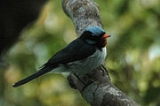
Blue-crested Flycatcher
Encyclopedia

Bird
Birds are feathered, winged, bipedal, endothermic , egg-laying, vertebrate animals. Around 10,000 living species and 188 families makes them the most speciose class of tetrapod vertebrates. They inhabit ecosystems across the globe, from the Arctic to the Antarctic. Extant birds range in size from...
in the monarch flycatcher family Monarchidae. It is endemic to Fiji
Fiji
Fiji , officially the Republic of Fiji , is an island nation in Melanesia in the South Pacific Ocean about northeast of New Zealand's North Island...
, where it is found on the islands of Viti Levu
Viti Levu
Viti Levu is the largest island in the Republic of Fiji, the site of the nation's capital, Suva, and home to a large majority of Fiji's population.- Geography and economy :...
, Vanua Levu
Vanua Levu
Vanua Levu , formerly known as Sandalwood Island, is the second largest island of Fiji. Located 64 kilometres to the north of the larger Viti Levu, the island has an area of 5,587.1 km² and a population of some 130,000.- Geography :...
and Taveuni
Taveuni
Taveuni is the third-largest island in Fiji, after Vanua Levu and Viti Levu, with a total land area of 435 square kilometers . The cigar-shaped island, a massive shield volcano which rises from the floor of the Pacific Ocean, is situated 6.5 kilometers to the east of Vanua Levu, across the...
.
Its natural habitat
Habitat
* Habitat , a place where a species lives and grows*Human habitat, a place where humans live, work or play** Space habitat, a space station intended as a permanent settlement...
s are subtropical or tropical moist lowland forest
Forest
A forest, also referred to as a wood or the woods, is an area with a high density of trees. As with cities, depending where you are in the world, what is considered a forest may vary significantly in size and have various classification according to how and what of the forest is composed...
s and subtropical or tropical moist montane
Montane
In biogeography, montane is the highland area located below the subalpine zone. Montane regions generally have cooler temperatures and often have higher rainfall than the adjacent lowland regions, and are frequently home to distinct communities of plants and animals.The term "montane" means "of the...
s.
Taxonomy
The Azure-crested Flycatcher was first described in 1875 by ornithologist Edgar Leopold LayardEdgar Leopold Layard
Edgar Leopold Layard CMG, FZS, MBOU was a British naturalist mainly interested in ornithology. Born in Florence, Italy, to a family of Huguenot descent, he was the sixth son of Henry Peter John Layard of the Ceylon Civil Service with his wife Marianne,...
, Administrator of the Government of the Colony of Fiji at the time. Its specific epithet is derived from the Latin
Latin
Latin is an Italic language originally spoken in Latium and Ancient Rome. It, along with most European languages, is a descendant of the ancient Proto-Indo-European language. Although it is considered a dead language, a number of scholars and members of the Christian clergy speak it fluently, and...
azureus 'blue', and capillus 'of the head'. It is also commonly known as the Blue-crested Broadbill, or the Azure-crested Flycatcher.
It is a member of a group of birds termed monarch flycatchers. This group is considered either as a subfamily Monarchinae, together with the fantail
Fantail
Fantails are small insectivorous birds of southern Asia and Australasia belonging to the genus Rhipidura in the family Rhipiduridae...
s as part of the drongo family Dicruridae, or as a family Monarchidae in its own right. They are not closely related to either their namesakes, the Old World flycatcher
Old World flycatcher
The Old World flycatcher family Muscicapidae is a large family of small passerine birds mostly restricted to the Old World. These are mainly small arboreal insectivores, many of which, as the name implies, take their prey on the wing.-Characteristics:...
s of the family Muscicapidae; early molecular research in the late 1980s and early 1990s revealed the monarchs belong to a large group of mainly Australasian birds known as the Corvida
Corvida
The "Corvida" were one of two "parvorders" contained within the suborder Passeri, as proposed in the Sibley-Ahlquist taxonomy. Standard taxonomic practice would place them at the rank of infraorder....
parvorder comprising many tropical and Australian passerines. More recently, the grouping has been refined somewhat as the monarchs have been classified in a 'Core corvine' group with the crows and ravens, shrikes, birds of paradise, fantails, drongos and mudnest builders.
There are three subspecies of Azure-crested Flycatcher. The nominate race Myiagra azureocapilla azureocapilla breeds in Taveuni, M. a. castaneigularis in Vanua Levu (except the Natewa Peninsula) and M. a. whitneyi in Viti Levu.
Description
Measuring 14 cm (5.5 in) in length, the Blue-crested Flycatcher is sexually dimorphic. The male has light blue crown with slate-blue upperparts, and white underparts. The female in brown above with greyish tinged cheeks and bluish tinged crown. Unusually for the genus MyiagraMyiagra
Myiagra is a genus of monarch flycatcher, sometimes referred to as the broad-billed flycatchers or simply broadbills...
the bill is bright orange instead of black.

